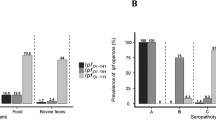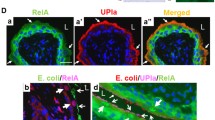Summary
An experimental pyelonephritis model was developed in monkeys (Macaca fascicularis) using P-fimbriatedEscherichia coli as the infecting organism. The relevant receptor molecules for P-fimbriae were also shown to be present inMacaca fascicularis. Atraumatic administration of P-fimbriatedE. coli into the ureter induced a ureteritis followed by acute and chronic pyelonephritis. The decisive role of P-fimbriae as an adhesive virulence factor was proven by the receptor blockade of P-fimbriae-mediated bacterial adhesion by a synthetic receptor analogue (α-D-Galp-(1–4)-β-D-Galp-1-OMe), which was administered into the ureter together with the challenge bacteria. On the basis of these and other findings, the role of reflux and pyelonephritis in relation to renal scarring is discussed in this paper. It is proposed that minor transitional vesicoureteral reflux together with the adhesive property of P-fimbriatedE. coli and their ability to induce ureteritis might constitute an alternative mechanism to gross reflux by which bacteria ascend to the kidney. These findings and the fact that intestinal colonization with P-fimbriatedE. coli coincides with the disease have opened up new prophylactic and therapeutic possibilities.
Zusammenfassung
Bei Affen (Macaca fascicularis) wurde ein experimentelles Pyelonephritis-Modell entwickelt; als infizierender Keim dienten P-Fimbrien-tragendeEscherichia coli. Die entscheidenden Rezeptormolekule der P-Fimbrien waren auch beiMacaca fascicularis nachzuweisen. P-Fimbrien-tragendeE. coli wurden atraumatisch in den Ureter eingeführt, sie induzierten eine Ureteritis, aus der sich eine akute und dann eine chronische Pyelonephritis entwickelte. Durch Blockade des Rezeptors für durch P-Fimbrien vermittelte Bakterienadhäsion konnte bewiesen werden, daß P-Fimbrien eine entscheidende Rolle für den Virulenzfaktor Adhäsion spielen; dabei wurde ein synthetisches Rezeptor-Analogon (α-D-Galp-(1–4)-β-D-Galp-1-OMe) mit den Erregern in den Ureter eingebracht. Auf der Basis dieser und anderer Untersuchungsergebnisse wird die Bedeutung von Reflux und Pyelonephritis für die renale Narbenbildung diskutiert. Es wird postuliert, daß ein geringfügiger, vorübergehender vesico-ureteraler Reflux zusammen mit dem Haftvermögen P-Fimbrien-tragenderE, coli und ihrer Fähigkeit, eine Ureteritis zu induzieren, pathogenetisch eine Alternative für die Aszension von Bakterien in die Niere darstellen könnte. Diese Feststellung und die Tatsache, daß die Kolonisation des Darmes mit P-Fimbrien-tragendenE. coli mit der Erkrankung zusammentrifft, eröffnen neue prophylaktische und therapeutische Möglichkeiten.
Similar content being viewed by others
Literature
Källenius, G., Möllby, R., Svenson, S. B., Helin, I., Hultberg, H., Cedergren, B., Winberg, J. Occurrence of P-fimbriatedEscherichia coli in urinary tract infections. Lancet II (1981) 1369–1372.
Svenson, S. B., Hultberg, H., Källenius, G., Korhonen, T. K., Möllby, R., Winberg, J. P-fimbriae of pyelonephritogenicEscherichia coli: Identification and chemical characterization of receptors. Infection 11 (1983) 61–67.
Filly, R., Friedland, G. W., Govan, E. D., Fair, W. R. Development and progression of clubbing and scarring in children with recurrent urinary tract infections. Radiology 113 (1974) 145–153.
Hodson, C. J., Edwards, D. Chronic pyelonephritis and vesicoureteric reflux. Clin. Radiol. II (1960) 219–231.
Ransley, P. G., Risdon, R. A. Renal papillary morphology in infants and young children. Urol. Res. 3 (1975) 111–113.
Rolleston, G. L., Maling, T. M. J., Hodson, C. J. Intrarenal reflux and the scarred kidney. Arch. Dis. Child. 49 (1974) 531–539.
Smellie, J. M., Normand, I. C. S. Bacteriuria, reflux and renal scarring. Arch. Dis. Child. 50 (1975) 581–585.
Winberg, J., Andersen, H. J., Bergström, T., Jacobsson, B., Larson, H., Lincoln, K. Epidemiology of symptomatic urinary tract infection in childhood. Acta Paediatr. Scand. 252 Suppl. (1974) 1–20.
Winberg, J., Bergström, T., Jacobsson, B. Morbidity, age and sex distribution, recurrences and renal scarring in symptomatic urinary tract infection in childhood. Kidney Int. 8 Suppl. (1975) 101–106.
Köllermann, M. W., Ludwig, H. Über den vesico-ureteralen Reflux beim normalen Kind im Säuglings- und Kleinkindalter. Z. Kinderheilkd. 100 (1967) 185–191.
Baker, R., Maxted, W., Maylath, J., Shuman, I. Relation of age, sex and infection to reflux: Data indicating high spontaneous cure rate in pediatric patients. J. Urol. 95 (1966) 27–32.
Roberts, J. A., Kaack, B., Källenius, G., Möllby, R., Winberg, J., Svenson, S. B.: Receptors for pyelonephritogenicEscherichia coli and prevention of acute pyelonephritis by receptor blockade in primates. (submitted for publication).
Roberts, J. A. Experimental pyelonephritis in the monkey. III. Pathophysiology of ureteral malfunction induced by bacteria. Invest. Urol. 13 (1975) 117–120.
Roberts, J. A., Riopelle, A. J. Vesico-ureteral reflux in the primate. III. Effect of urinary tract infection on maturation of the ureterovesical junction. Pediatrics 61 (1978) 853–857.
Angel, J. R., Smith, T. W., Jr., Roberts, J. A. The hydrodynamics of pyelorenal reflux. J. Urol. 122 (1979) 20–26.
Author information
Authors and Affiliations
Rights and permissions
About this article
Cite this article
Källenius, G., Svenson, S.B., Möllby, R. et al. P-fimbriae of pyelonephritogenic escherichia coli: Significance for reflux and renal scarring — A hypothesis. Infection 11, 73–76 (1983). https://doi.org/10.1007/BF01651364
Issue Date:
DOI: https://doi.org/10.1007/BF01651364




